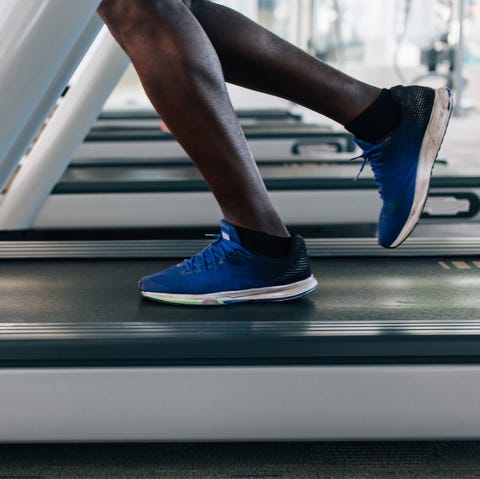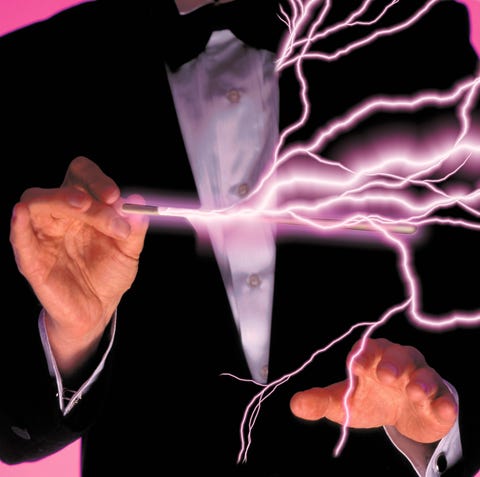Imagine building bigger, stronger muscles without ever lifting a weight.
Imagine walking into a gym, putting on a bodysuit covered with electrodes, and going through a “workout” without breaking a sweat.
Imagine those electrodes zapping your muscles into higher levels of activation, and because of that high-tech stimulus, you achieving new levels of mass and power—levels you would have otherwise never achieved on the bench or in the squat rack.
That’s the pitch for a new wave of gyms offering whole-body electrical muscle stimulation (EMS). Nova Fitness says their EMS workouts are “three times more efficient than your traditional workout,” while Manduu claims 15 minutes of EMS “can equal six to eight hours of traditional strength training.”

Mubariz Khan / EyeEm
In theory, it makes some sense. Anyone who’s seen The Matrix knows the human body is literally electric. We create electricity to keep ourselves alive, and we respond to it when something goes wrong.
That’s why paramedics use a defibrillator to jump-start a stalled cardiac muscle. Doctors and physical therapists have used local EMS, with the electrodes placed on a single muscle, for decades. It’s a valuable tool to help speed recovery and limit muscle loss from injuries.
But whole-body EMS is new, and wholly different from the therapeutic model. For sessions that typically take 30 minutes or less, sold in packages that cost as little as $35 per workout, they promise all the results of gym training with a fraction of the time and effort. Could that possibly be true?
Big Promises, Slim Evidence
Studies on whole-body EMS are all over the place. Research teams have used it in different ways, with different populations, in different circumstances. When researchers in Spain tried to wrangle all of it for a systematic review, they found it’s impossible to draw any conclusions.

twinsterphoto
Same with another type of EMS, which promises “muscle sculpting” using a device called the truSculpt Flex. The treatments concentrate on one muscle group at a time—usually the abs—with electrodes that hit up to eight areas simultaneously.
“If they’re planning to improve the appearance and the overall muscle thickness of the core, this is a really great device,” says Michael Somenek, M.D., a plastic surgeon in Washington, D.C.
In his own trials, he says he’s seen increases in the muscle thickness of the rectus abdominis of up to 24 percent. That’s with four 45-minute treatments in two weeks, at a cost of hundreds of dollars per session.
One study that directly compared whole-body EMS with strength training found similar increases in strength and muscle mass. But those who lifted did slightly better, and they did it with a program few personal trainers with legitimate credentials would recommend for newbie lifters: one set to failure of 10 to 13 exercises, done twice per week.
But the real problem with whole-body EMS is what the companies selling it don’t want you to know.
Shots in the Dark
Nicola Maffiuletti, Ph.D., has researched EMS for some 20 years—first with athletes at a university in France, and now with patient populations at an orthopedic clinic in Switzerland. Most of his studies involved local EMS, activating one muscle at a time. Finding the optimal intensity—enough to stimulate the tissue, but not so much you damage it—requires a rigorous protocol. It’s different for every person and every muscle.

Michael H
Imagine the challenge of finding the right intensity for every muscle group simultaneously. “There’s no way for trainers to select the right dose,” Maffiuletti says. He learned that first-hand, when he tried whole-body EMS a few years ago. “I’m pretty active, and I had soreness for a month.”
Some users, he learned, had more than soreness. A physician in Israel told him he’d seen three patients who’d gone to the ICU for kidney damage following whole-body EMS. They were diagnosed with rhabdomyolysis, a potentially fatal condition caused by extreme muscle damage.
Wolfgang Kemmler, Ph.D., one of the most prolific exercise scientists studying the topic, concedes that whole-body EMS is “a perfect tool to trigger severe and long-lasting” muscle damage, which ranges from delayed-onset muscle soreness to rhabdomyolysis.
To Kemmler, EMS can be “a good option for people with low time resources, joint limitations, or simple aversion against conventional resistance exercise.” But much depends on the trainer, and how well he or she can modulate the intensity to sufficiently stimulate multiple muscle groups without painful or even catastrophic damage.
Trainer and physical therapist Chad Waterbury, D.P.T., puts it more bluntly: “It’s for people who don’t like to work out.”

Comstock
Waterbury often uses local EMS with patients recovering from surgery. After ACL repair, for example, the patients can’t activate their quadriceps completely. Electrical stimulation helps those muscles generate the force they need to return to normal.
“I don’t use it all for healthy people, and don’t recommend it,” he says. “You want your nervous system to develop through voluntary actions—trying to lift heavier weights, or trying to move light loads faster. There’s no evidence EMS will lead to those benefits for people that are consistently lifting weights.”
Maffiuletti’s assessment is equally blunt. “I always conclude it’s not at all safe,” he says. “It’s not at all effective. And I do not recommend its use, especially at this stage.”
Source: Read Full Article
